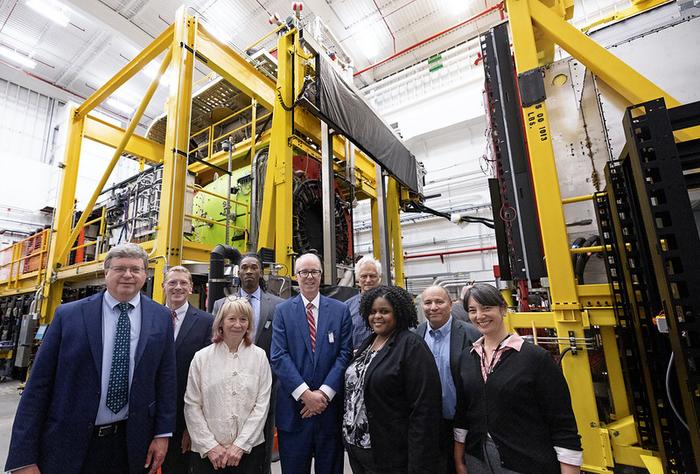NEWPORT NEWS, VA – On April 18, the U.S. Department of Energy’s Thomas Jefferson National Accelerator Facility welcomed Under Secretary for Science and Innovation Geraldine (Geri) Richmond for a tour of the lab and briefing on its research mission, innovation and STEM programs.

Credit: DOE’s Jefferson Lab/Aileen Devlin
NEWPORT NEWS, VA – On April 18, the U.S. Department of Energy’s Thomas Jefferson National Accelerator Facility welcomed Under Secretary for Science and Innovation Geraldine (Geri) Richmond for a tour of the lab and briefing on its research mission, innovation and STEM programs.
Throughout the day, much of the conversation centered on a common theme of how the lab is working to ensure it is a hub of engagement, partnership, and access for researchers, students, community leaders and others. Ensuring diverse communities have access to the programs, support and opportunities offered by DOE and its national labs is a key priority for the lab and its future.
“Jefferson Lab, along with all of the DOE National Labs and the Office of Science, is working hard to diversify its research portfolio to better include historically underrepresented institutions and researchers,” said Richmond.
The day started with meetings with on-site DOE staff. Jefferson Lab Director Stuart Henderson then gave a brief introduction to the lab, its mission and research.
“Our long-term mission is to advance our understanding of the building blocks of matter, and that’s recently been joined by a new focus on high performance computing and data science,” Henderson said. “As we move forward into the future, we intend to deliver on these priorities with steadfastness but also agility. And we will also continue to share our innovations to benefit the nation, our passion for educating the next generation, and our desire to positively impact our region’s economy.”
Later, the visit turned to discuss highlights of individual programs and initiatives that support the lab’s mission. One highlight focused on the many programs the lab offers to students and educators to ensure these key groups benefit from the knowledge, expertise and support the national labs have to offer. Another discussion centered on artificial intelligence, machine learning and computing resources, including the new High Performance Data Facility (HPDF) project that is currently in the conceptual design phase.
“HPDF is a partnership between Jefferson lab and Lawrence Berkeley National Lab, and we’ve set the whole project up like that,” said Jefferson Lab Deputy Director for Science David Dean. “HPDF represents a unique opportunity to transform and accelerate scientific discoveries and innovation by providing a seamless data life cycle to users across Office of Science experimental and computational facilities. I believe HPDF will be a game changer in the way we perform science.”
Updates on projects being pursued by the lab’s Biomedical Research & Innovation Center focused on how BRIC members and their projects are jump-starting conversations with those in the medical and biomedical fields to ensure key nuclear physics technologies are being applied to significant challenges these fields face.
Another discussion centered on the many partnership efforts the lab has recently undertaken to bring together community and business leaders with lab and energy representatives to discuss ways that these groups can work together to benefit our local communities and the nation. Ensuring these groups are aware of opportunities to engage in DOE programs and have access to those programs to support their work can lead to real-world, innovative solutions to problems in energy, coastal and environmental challenges with local impacts.
“Legislation signed by President Biden, the Bipartisan Infrastructure Law and Inflation Reduction Act, is sending a once-in-a-generation amount of investment into communities to improve infrastructure, address climate change, and create jobs,” Richmond said. “Our DOE Laboratories can serve as community advisers to help make sure these investments are going where they are most needed.”
Also during the visit, a short tour of the lab began with a trip to the control room of the lab’s world-leading particle accelerator, the Continuous Electron Beam Accelerator Facility. Led by the group leader for the Machine Control Center, Paul Vasilauskis, the delegation entered the control room to watch as CEBAF’s accelerator operators delivered electron beams to three of CEBAF’s four experimental halls for experiments. CEBAF is a DOE user facility that supports the research of more than 1,900 nuclear physicists worldwide.
The second stop on the tour featured the lab’s Experimental Hall D. There, Hall D Leader Eugene Chudakov focused on the physics mission of the lab. Hall D features the GlueX detector systems, which are enabling a new understanding of the force that glues together the building block of matter, protons and neutrons, in the nucleus of the atom.
On the last stop, Under Secretary Richmond and guests visited the Institute for Superconducting Radiofrequency Science and Technology. There, SRF Science and Technology Department Head Rongli Geng and Accelerator Physicist Anne-Marie Valente-Feliciano showed off the lab’s recent gains in unlocking the secrets of superconductivity in SRF materials and several large particle accelerator sections under assembly.
Click here for photo highlights from the visit.
-end-
Jefferson Science Associates, LLC, manages and operates the Thomas Jefferson National Accelerator Facility, or Jefferson Lab, for the U.S. Department of Energy’s Office of Science.
DOE’s Office of Science is the single largest supporter of basic research in the physical sciences in the United States and is working to address some of the most pressing challenges of our time. For more information, visit https://energy.gov/science.
Discover more from Science
Subscribe to get the latest posts sent to your email.


